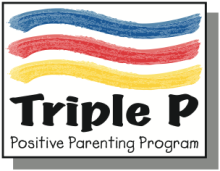Triple P – Positive Parenting Program® (Triple P) is a parenting and family support system that serves families with children from birth through age 16. The system includes multiple interventions that increase in intensity across five levels of service. Within each level, there is a range of delivery methods to meet different family needs and be appropriate for multiple cultures. Home visiting is one of the methods of delivering services within some levels.
No Triple P level or intervention is exclusively delivered in the home with families with children from birth through age 5. This profile is based on (1) studies of programs that provided Triple P services in the home to families with children from birth through age 5, and (2) developer input on the Triple P interventions suitable for delivery in the home with families with children from birth through age 5. HomVEE refers to the approach to delivering Triple P in the home with families with children birth through age 5 as Triple P–Variants suitable for home visiting*.
Triple P draws on social learning theory, cognitive behavioral development, and research on the risk factors associated with social and behavioral problems in children.
The system’s five levels are organized by the degree of parental need or child behavioral difficulties. Intensity ranges from Level 1, a population-wide communication strategy, to Level 5, which addresses issues that complicate parenting such as partner conflict, stress, mental illness, risk of child maltreatment, and anger management. Below is a brief description of each level, including whether home visiting can be used as a service delivery method.
- Levels 1 and 2 do not involve home visiting.
- Level 1 is a community-wide communications strategy designed to promote the importance of parenting and raise awareness of parenting needs throughout a community.
- Level 2 provides parents with minor concerns about their child’s behavior or development brief parenting advice through a one-time parenting seminar or consultation.
- Levels 3 through 5 can involve home visiting.
- Level 3 provides narrowly focused parenting skills training targeting a specific behavioral problem or issue through face-to-face or telephone sessions with a practitioner or small group sessions. The Triple P interventions offered at this level include Primary Care Triple P and Triple P Discussion Groups.
- Level 4 provides broadly focused parenting skills training. This level offers four interventions: (1) Group Triple P, involving group sessions and phone or home-based sessions; (2) Standard Triple P, involving individual counseling sessions for parents who require intensive support; (3) Triple P Online, a web-based curriculum; and (4) Self-Help Triple P, a self-help workbook with phone consultations.
- Level 5 provides more intensive family interventions that support parents who face complex parenting issues. The Level 5 interventions include (1) Enhanced Triple P for parents experiencing partner conflict, stress, or mental health issues, and (2) Pathways Triple P, which provides behavioral strategies for parents at risk of child maltreatment. Parents must participate in a Level 4 intervention before or in conjunction with Enhanced or Pathways Triple P.
Implementing agencies select the intensity, intervention, and delivery setting that reflects their organization’s priorities and budgets. For example, agencies can implement multiple Triple P interventions across levels to reach an entire population or select a Triple P intervention designed for a particular parenting group or demographic.
The following Triple P interventions are suitable for delivery in the home: Primary Care Triple P (Level 3), Standard Triple P (Level 4), Enhanced Triple P (Level 5), and Pathways Triple P (also Level 5).
Triple P also includes five adaptations for certain subgroups: (1) Stepping Stones Triple P for families with children with a disability, (2) Family Transitions Triple P for families in which parents are going through separation or divorce and have concerns about their children’s behavior, (3) Indigenous Triple P for indigenous families with children from birth through age 12, (4) Group Lifestyle Triple P for families with parents concerned about their children’s overweight or obesity and activity level, and (5) Teen Triple P for parents of teenagers through age 16. Family Transitions Triple P, Indigenous Triple P, and some versions of Stepping Stones Triple P (described in Adaptations and Enhancements) also are suitable for delivery in the home.
*In this profile, when a description or requirement is specific to delivering Triple P in the home with families with children from birth through age 5, the profile specifies that, such as by saying: “when delivering Triple P in the home…”. Otherwise, if a description or requirement applies to Triple P interventions across all settings, service delivery methods, and target populations, the profile says “Triple P…”.
